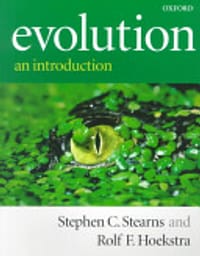
| ISBN | 9780198549680 |
| Författare | Stephen C. Stearns, Rolf F. Hoekstra |
| Publiceringsår | 2000 |
| Antal sidor | 381 |
2000
Ej tillgänglig
Ej tillgänglig
Ej tillgänglig
Ej tillgänglig
Denna bok finns att köpa begagnad av dessa säljare. Välj en eller flera för att skicka ett meddelande till dem om att du vill köpa boken. Priser alltid inkl. frakt.

Bra skick
Boken Evolution släpptes år 2000 och är skriven av Stephen C. Stearns och Rolf F. Hoekstra.
Den består av 381 sidor.
Köp Evolution begagnad från en av 1 studenter hos oss och spara pengar. Vi kunde inte hitta något pris på vad den kostar ny, men den kostar bara 159 kr begagnad.
A major new textbook. A concise and clear introduction to evolutionary biology. This book introduces what is essential and exciting in evolutionary biology. It covers whole field and emphasises the important concepts for the student. Care has been taken to express complex and stimulating ideas in simple language, while the frequent examples and running summaries make readingfun. Its logical structure means that it can be read straight through, one chapter per sitting. * Concise, clear, and states what is important * Concentrates on the central concepts and illustrates them with telling examples * Running summaries in the margins make navigation easy * Suitable for a one-year or one-semester course in evolution * Summaries at chapter ends * Each chapter's links to neighbouring chapters are explained Evolution: an introduction takes a fresh approach to classical topics such as population genetics and natural selection, and gives an overview of recent advances in hot areas such as sexual selection, genetic conflict, life history evolution, and phenotypic plasticity. Detail of contents The Prologue is unique and uniquely motivating. It makes four central points about evolution in the form of four case studies told as brief stories. Chapters 1-3 describe natural selection and the essential difference between adaptive and neutral evolution with unmatched clarity and simplicity. Chapter 4 emphasizes the essential message of population genetics without burdening the students with any of the unessential details and places unique emphasis on the role of the genetic system in constraining the response to selection. Chapter 6 is not found in any other evolution textbook, although there are a number of recent books on the subject, and it therefore provides an introductory overview of a topic that has been the object of much recent interest and promises to generate much more insight: the expression of geneticvariation analysed with the concept of reaction norms. Chapters 7-9 cover sex, life histories, and sexual selection in greater depth than they are dealt with in any other introductory textbook but without introducing advanced technical language and analysis. Chapters 6-9 thus give unprecedented coverage to phenotypic evolution in an introductory text. Chapter 10 on multilevel selection and genetic conflict is unique in introductory textbooks. Rolf Hoekstra has achieved a wonder of clarity and concision on the essentials of this exciting topic. Chapters 11 and 12 on speciation and systematics are, by comparison, pretty standard, but they continue the policy of clarity and concision with the focus on essentials. Chapter 13 on the history of the planet and of life is a completely new approach unabashedly designed to motivate students to think about deep time, geology, paleontology, and fossils. Chapter 14 on the major transitions in evolution is also not found in any other introductory textbook. It documents the conceptual issues raised in the history of life briefly and in a form that will stimulate the gifted. Chapter 15 profiles the chief insights made possible by molecular systematics in the form of four case studies ranging from deep time to recent European history. It has standard content but unique structure. A strong point is the way mitochondrial Eve is contrasted with transpecies polymorphismto show students how to think about inferences with molecular evidence. Chapter 16 briefly presents the principle comparative methods and the kinds of insights that can be achieved with them. It is not unique - Ridley covers this ground well - but the examples used are new and the essential features of the methods - including potential pitfalls - are quite clearlydescribed. Chapter 17 places evolutionary thought into the context both of the natural sciences and of society at large.
Nu när du vet att du vill köpa denna bok begagnad, och den finns tillgänglig så trycker du på den gröna knappen under annonserna för att komma i kontakt med säljarna.
Säljaren skickar en köpesförfrågan till dig som du enkelt accepterar. Säljaren får din adress för att skicka boken och du får instruktioner om hur du ska Swisha.
När du är färdig med din kurs så är nästa rimliga steg att du säljer boken till nästa års kull.
Det är helt gratis att sälja en bok på BegagnadKurslitteratur.se!